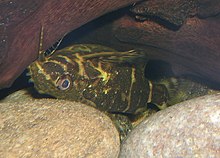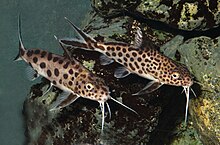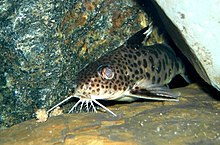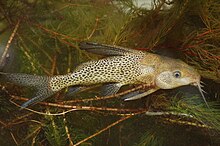Synodontis
| Synodontis | ||||||||||||
|---|---|---|---|---|---|---|---|---|---|---|---|---|

Fiederbartwels Synodontis cf. vanderwaali from the Okavango / Namibia |
||||||||||||
| Systematics | ||||||||||||
|
||||||||||||
| Scientific name | ||||||||||||
| Synodontis | ||||||||||||
| Cuvier , 1816 |
Synodontis is a genus of the whiskered catfish (Mochokidae), a catfish family that is only found in Africa.
The name Synodontis is derived from a name for a fish that was first mentioned by Pliny . Cuvier , who initially took up the name for a subgenus, believed that it was used for a fish from the Nile in ancient times. Most of the species described above also come from the Nile. The oldest known of these, Synodontis clarias , is also the type species of the genus. It was described by Linnaeus as early as 1758 .
Research into the genus is still in full swing. In recent years, more and more scientifically new species have been described, but phylogenetic studies based on molecular studies have also been published.
description
The majority of the Synodontis species have a moderately compact body that is slightly flattened on the sides. The upper profile line is strongly curved. Dorsal and pectoral fins each have a strong, often toothed spine. The adipose fin is relatively large and without a supporting ray. Three pairs of barbels are attached relatively far in front of the head. The two maxillary barbels are the longest and only exceptionally feathered, but sometimes have a membrane at the base. Those of the lower jaw are almost always feathered and significantly shorter than those of the upper jaw. In many species, the males can be recognized by a small "rod" that forms the genital opening. In 1990 it was discovered that synodontal species with swim bladder muscles generate electrical fields for communication (Hagedorn et al. ).
Occurrence
Synodontis species are distributed from the Nile in Egypt in the far north of Africa to South Africa, in the west from Senegal and Gambia to coastal rivers in Tanzania and Kenya . The Congo River , but also Lake Tanganyika, are certainly focal points with a strong species division .
Way of life

Field observations are relatively rare, as many species live in waters with poor visibility. From aquarium observations we know that numerous Synodontis species prefer a hidden way of life during the day and only really wake up at night. However, many of these fish quickly get used to life in captivity and even become trusting. In other words, they can even be petted on their tummy while feeding. Several Synodontis species like to eat food from the surface of the water. Some species, such as the back- swimming Congo cat , even prefer to lie on their back as their normal swimming position. However, it is also known of other species (e.g. Synodontis eupterus ) that they occasionally swim around in a supine position, even when they are not eating from the surface of the water. Presumably they live in nature on the embankment under the roots of trees that extend their foothills into the water. In the supine position you will find the soft belly protected by the branches and from below the defensive back sting and the head armor protect you from predators. There are reports from Lake Tanganyika that the cuckoo whiskered catfish can appear in schools so large that the fishermen's nets are so full of fish that they are no longer able to overtake them, because otherwise they run the risk of the small ones Capsizing boats.
Reproduction
Most Synodontis species do not practice brood care. It is known of some species that they simply release their eggs and sperm into the water in caves and crevices and, as parent animals, attack their own spawn. Fertilized eggs that fall into crevices develop into larvae there, which soon swim freely. Brood parasitism is also known from two species so far ( cuckoo whiskered catfish and Synodontis grandiops ), in which the eggs of the catfish are pushed beneath the spawning mouth -brooding cichlids .
use
Numerous Synodontis species are popular aquarium fish. Most, but not all, species are tolerable inhabitants who do not harm their own kind or other aquarium inhabitants. The species from Lake Tanganyika in particular are popular aquarium keepers. It should not be forgotten, however, that all Synodontis species are not only potential (young) fish-eaters (fish larvae and fish spawn in particular are at risk), but also cause a certain restlessness in the aquarium due to their nocturnal lifestyle, which stresses sensitive roommates . Fiederbart catfish can get relatively old when cared for by humans. Nursing periods of over 30 years are documented.
There are different reports about whether Synodontis species are valued as food fish. Although they are offered as such on the markets in Africa, early authors write that they are not particularly popular with consumers because their meat does not taste good.
species
There are currently about 130 known species:

- Synodontis acanthomias Boulenger, 1899
- Synodontis acanthoperca Friel & Vigliotta, 2006
- Synodontis afrofischeri Hilgendorf, 1888
- Synodontis alberti Schilthuis, 1891
- Synodontis albolineatus Pellegrin, 1924
- Guinea fowl catfish ( Synodontis angelicus ) Schilthuis, 1891
- Synodontis annectens Boulenger, 1911
- Synodontis ansorgii Boulenger, 1911
- Synodontis arnoulti Roman, 1966
- Synodontis aterrimus Poll & Roberts, 1968
- Synodontis Bastiani Daget, 1948
- Synodontis batesii Boulenger, 1907
- Synodontis batensoda (Rüppell, 1832)
- Synodontis brichardi Poll, 1959
- Synodontis budgetti Boulenger, 1911
- Synodontis camelopardalis Poll, 1971
- Synodontis carineae Vreven & Ibala Zamba, 2011
- Caudal synodontis Boulenger, 1899
- Synodontis caudovittatus Boulenger, 1901
- Synodontis centralis Poll, 1971
- Synodontis clarias (Linnaeus, 1758)
- Synodontis comoensis Daget & Lévêque, 1981
- Synodontis congicus Poll, 1971
- Synodontis contractus Vinciguerra, 1928
- Synodontis courteti Pellegrin, 1906
- Synodontis cuangoanus Poll, 1971
- Synodontis dageti Poll & Roman, 1967
- Synodontis decorus Boulenger, 1899
- Synodontis dekimpei Paugy, 1987
- Synodontis denticulatus Kasongo Ilunga et al., 2019
- Synodontis depauwi Boulenger, 1899
- Synodontis dhonti Boulenger, 1917
- Synodontis dorsomaculatus Poll, 1971
- Synodontis eburneensis Daget, 1965
- Synodontis eupterus Boulenger, 1901
- Synodontis fascipinna Nichols & La Monte, 1953
- Synodontis filamentosus Boulenger, 1901
- Synodontis flavitaeniatus Boulenger, 1919
- Synodontis frontosus Vaillant, 1895
- Synodontis fuelleborni Hilgendorf & Pappenheim, 1903
- Synodontis geledensis Günther, 1896
- Synodontis gobroni Daget, 1954
- Synodontis grandiops Wright & Page, 2006
- Synodontis granulosus Boulenger, 1900
- Synodontis grenshoffi Schilthuis, 1891
- Synodontis guttatus Günther, 1865
- Synodontis haugi Pellegrin, 1906
- Synodontis hollyi Pellegrin, 1929 [species inquirenda]
- Synodontis ilebrevis Wright & Page, 2006
- Synodontis irsacae Matthes, 1959
- Synodontis ituriensis Boulenger, 1920
- Synodontis iturii Steindachner, 1911
- Synodontis katangae Poll, 1971
- Synodontis khartoumensis Gideiri, 1967
- Synodontis koensis Pellegrin, 1933
- Synodontis kongonensis Musschoot & Lalèyè, 2008
- Synodontis laessoei Norman, 1923
- Synodontis latifrons Blache, 1964
- Synodontis leopardinus Pellegrin, 1914
- Synodontis leopardus pepper, 1896
- Synodontis levequei Paugy, 1987
- Synodontis longirostris Boulenger, 1902
- Synodontis longispinis Pellegrin, 1930
- Synodontis lucipinnis Wright & Page, 2006
- Synodontis lufirae Poll, 1971
- Synodontis macrophthalmus Poll, 1971
- Synodontis macrops Greenwood, 1963
- Synodontis macropunctatus Wright & Page, 2008
- Synodontis macrostigma Boulenger, 1911
- Synodontis macrostoma Skelton & White, 1990
- Synodontis maculosus Rüppell, 1829
- Synodontis manni De Vos, 2001
- Synodontis marmoratus Lönnberg , 1895
- Synodontis matthesi Poll, 1971
- Synodontis melanopterus Boulenger, 1903
- Synodontis melanostictus Boulenger, 1906
- Synodontis membranaceus (Geoffroy St. Hilaire, 1809)
- Synodontis multimaculatus Boulenger, 1902
- Cuckoo's whiskered catfish ( Synodontis multipunctatus ) Boulenger, 1898
- Synodontis nebulosus Peters, 1852
- Synodontis ngouniensis De Weirdt, Vreven & Fermon, 2008
- Synodontis nigrita Valenciennes, 1840
- Back swimming Congo Catfish ( Synodontis nigriventris ) David, 1936
- Synodontis nigromaculatus Boulenger, 1905
- Synodontis njassae Keilhack, 1908
- Synodontis notatus Vaillant, 1893
- Synodontis nummifer Boulenger, 1899
- Synodontis obesus Boulenger, 1898
- Synodontis ocellifer Boulenger, 1900
- Synodontis omias Günther, 1864
- Synodontis orientalis Seegers, 2008
- Synodontis ornatipinnis Boulenger, 1899
- Synodontis ornatissimus Gosse, 1982
- Synodontis ouemeensis Musschoot & Lalèyè, 2008
- Synodontis pardalis Boulenger, 1908
- Synodontis petricola Matthes, 1959
- Synodontis pleurops Boulenger, 1897
- Synodontis polli Gosse, 1982
- Synodontis polyodon Vaillant, 1895
- Synodontis polystigma Boulenger, 1915
- Synodontis pulcher Poll, 1971
- Synodontis punctifer Daget, 1965
- Synodontis punctulatus Günther, 1889
- Synodontis punu Vreven & Milondo, 2009
- Synodontis rebeli Holly, 1926
- Synodontis resupinatus Boulenger, 1904
- Synodontis ricardoae Seegers, 1996
- Synodontis robbianus Smith, 1875
- Synodontis robertsi Poll, 1974
- Synodontis ruandae Matthes, 1959
- Synodontis rufigiensis Bailey, 1968
- Synodontis rukwaensis Hilgendorf & Pappenheim, 1903
- Synodontis sound (Bloch & Schneider, 1801)
- Synodontis schoutedeni David, 1936
- Synodontis serpentis Whitehead, 1962
- Synodontis serratus Rüppell, 1829
- Synodontis smiti Boulenger, 1902
- Synodontis soloni Boulenger, 1899
- Synodontis sorex Günther, 1864
- Synodontis steindachneri Boulenger, 1913
- Synodontis tanganyicae Borodin, 1936
- Synodontis tessmanni Pappenheim, 1911
- Synodontis thamalakanensis Fowler, 1935
- Synodontis thysi Poll, 1971
- Synodontis tourei Daget, 1962
- Synodontis unicolor Boulenger, 1915
- Synodontis vaillanti Boulenger, 1897 [species inquirenda]
- Synodontis vanderwaali Skelton & White, 1990
- Synodontis velifer Norman, 1935
- Synodontis vermiculatus Daget, 1954
- Synodontis victoriae Boulenger, 1906
- Synodontis violaceus Pellegrin, 1919
- Synodontis voltae Roman, 1975
- Synodontis waterloti Daget, 1962
- Synodontis woosnami Boulenger, 1911
- Synodontis xiphias Günther, 1864
- Synodontis zambezensis Peters, 1852
- Synodontis zanzibaricus Peters, 1868
swell
- ↑ Friel, JP & TR Vigliotta (2006): Synodontis acanthoperca, a new species from the Ogôoué River system, Gabon with comments on spiny ornamentation and sexual dimorphism in mochokid catfishes (Siluriformes: Mochokidae). Zootaxa , 1125: 45-56.
- ^ Wright, JJ & LM Page (2006): Taxonomic revision of Lake Tanganyikan Synodontis (Siluriformes: Mochokidae). Bulletin of the Florida Museum of Natural History , 46 (4): 99-154.
- ↑ Musschoot, T. & P. Lalèyè (2008): Designation of a neotype for Synodontis schall (Bloch and Schneider, 1801) and description of two new species of Synodontis (Siluriformes: Mochokidae). Journal of Natural History , 42 (17-18): 1303-1331.
- ↑ Day, JJ & M. Wilkinson (2006): On the origin of the Synodontis catfish species flock from Lake Tanganyika. biology letters , 2 (4): 548-552.
- ↑ Brain Behav Evol 1990; 35: 268-277 doi : 10.1159 / 000115873 .
- ↑ Schraml, E. (2003): Fiederbartwelse from Lake Tanganyika (Part 1). Datz , 56 (8): 60-65.
- ↑ Schraml, E. (2003): Fiederbartwelse from Lake Tanganyika (Part 2). Datz , 56 (10): 18-23.
- ↑ Synodontis on Fishbase.org (English)
- ↑ a b Thomas R. Vigliotta: A phylogenetic study of the African catfish family Mochokidae (Osteichthyes, Ostariophysi, Siluriformes), with a key to its genera (PDF; 643 kB). Proceedings of the Academy of Natural Sciences of Philadelphia, 157 (1): 73-136. 2008 doi : 10.1635 / 0097-3157 (2008) 157 [73: APSOTA] 2.0.CO; 2












